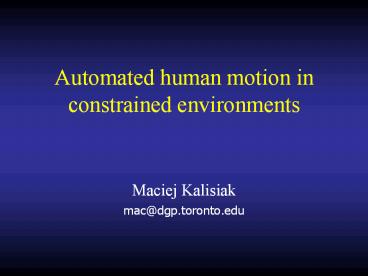Automated human motion in constrained environments PowerPoint PPT Presentation
Title: Automated human motion in constrained environments
1
Automated human motion in constrained environments
- Maciej Kalisiak
- mac_at_dgp.toronto.edu
2
Introduction
- human character animation
- constrained environments
- kinematic method
- currently 2D, extendible
- sample solution
3
Path Planning
- piano movers problem
- given start and goal configurations
- find connecting path
4
Application to Human Motion
5
Approach
- starting point RPP
- additions
- moving while in contact with environment
- notion of comfort
- knowledge of human gaits
6
Understanding RPP
- Randomized Path Planning
- a path planning algorithm
7
Simplest Planner
- characters state q
- repeated perturbations,i.e., Brownian motion
- repeat until goal reached
8
Building a Potential Field
- discretize into grid
- potential Manhattan distance to goal
- flood-fill
9
Gradient Descent
- character ? point mass
- sample qs neighbourhood
- pick sample with largest drop in potential
- iterate until goal reached
- not feasible analytically
10
Local Minima
- gradient descent stops at any minimum
- use random walks to escape
- Brownian motion of predetermined duration
- use backtracking if minimum too deep
- revert to a previous point in solution,followed
by a random walk
11
Deep Minimum Example
12
Smoothing
- solution embodies complete history of search
process - also very noisy
- a trajectory filter post-process is applied
- removes extraneous motion segments
- makes remaining motion more fluid
13
Modifications
- grasps and grasp invariants
- comfort heuristic system
- gait finite state machine
- grasp-aware gradient descent, random walk,
smoothing filters
14
Character Structure
- 10 links
- 9 joints
- 12 DOFs
- frequent re-rooting
15
Grasp Points
- represent potential points of contact
- three types
- reduce the grasp search space
- summarize surface characteristics
16
Grasp Invariants
- each gait dictates
- the number of grasps
- the types of grasps
- enforced by the GFSM
- rest of planner must not alter existing grasps
17
Motion without Heuristics
18
Heuristic System
- each heuristic measures some quality of q
- D(q) overall discomfort, a potential field
- getting comfy gradient descent through D(q)
19
Implemented Heuristics
20
The Gait FSM
- states represent gaits
- each edge has
- geometric preconditions
- motion recipe
- priority
- self-loops gait-preserving motion that changes
grasps
21
Complete System
22
More Results
23
Future Work
- 3D
- quadrupeds, other characters
- grasp surfaces
- non-limb grasping
- add concept of time, speed
- use machine learning
24
FIN
http//www.dgp.toronto.edu/mac/thesis
25
Appendix
- (extra slides)
26
Alternate gradient descent view
27
Smoothing Algorithm
28
Need for Limb Smoothing
29
Limb Smoothing Solution
30
Implemented GFSM
31
Contributions
- human character animation algorithmfor
constrained environments - grasp point discretization of environment
- grasp constraint
- comfort modeling using heuristics
- gait FSM
- adapted RPP algorithms to grasp constraint

